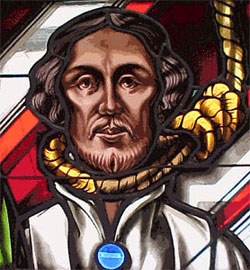
Feastday: September 8
Patron: of plague, epilepsy, arms dealers, butchers, guards, soldiers
Death: 306
According to legend Adrian was a pagan officer at the imperial court of Nicomedia. Impressed by the courage of a group of Christians who were being tortured, he declared himself a Christian and was imprisoned with them and suffered excruciating tortures before he was put to death. His young wife, Natalia, who was present at his death, comforted him in his agony, recovered one of his severed hands, and took it to Argyropolis near Constantinople, where she fled to escape the importunities of an imperial official of Nicomedia who wanted to marry her. She died there peacefully on December 1. Adrian is the patron of soldiers and butchers.
3rd-century martyred guard of the Roman emperor GaleriusAdrian of Nicomedia (also known as Hadrian) or Saint Adrian (Greek: Ἁδριανὸς Νικομηδείας, died 4 March 306) was a Herculian Guard of the Roman Emperor Galerius Maximian. After becoming a convert to Christianity with his wife Natalia, Adrian was martyred at Nicomedia in Turkey. Hadrian was the chief military saint of Northern Europe for many ages, second only to Saint George, and is much revered in Flanders, Germany and the north of France.
Martyrdom
 French statue of Saint Adrian
French statue of Saint Adrian
Adrian and Natalia lived in Nicomedia during the time of Emperor Maximian in the early fourth century. The twenty-eight-year-old Adrian was head of the praetorium.
It is said that while presiding over the torture of a band of Christians, he asked them what reward they expected to receive from God. They replied, "Eye hath not seen, nor ear heard, neither have entered into the heart of man, the things which God hath prepared for them that love him." He was so amazed at their courage that he publicly confessed his faith, though he had not yet been baptized. He was then immediately imprisoned. He was forbidden visitors, but accounts state that his wife Natalia came to visit him, dressed as a boy, to ask for his prayers when he entered Heaven.
The executioners wanted to burn the bodies of the dead, but a storm arose and quenched the fire. Natalia recovered one of Adrian's hands.
Historicity
The accuracy of the recorded story has been questioned. A second Hadrian, is said to have been a son of the Emperor Probus, and, having embraced Christianity, to have been put to death (A.D. 320), at Nicomedia in Asia Minor, by the Emperor Licinius. But no reliable information concerning him is extant. He is commemorated on August 26.
Feast day and patronage
 Russian Orthodox icon of the martyrs Adrian and Natalia.
Russian Orthodox icon of the martyrs Adrian and Natalia.
In the Eastern Orthodox Church, Saint Adrian shares a feast day with his wife on 26 August (Revised Julian calendar and/or Gregorian calendar), or on 8 September (most Orthodox Churches still use the historic Julian calendar); he also has feast days alone on 4 March. In the Roman Catholic Church, he is venerated alone, without his wife, on September 8. The Coptic Orthodox Church likewise venerates St. Adrian and his companions on the third day of the Coptic month known as Nesi (corresponding to September 8), mentioning his wife's role during the Synaxarion reading of that day; spelling in the Coptic Synaxarion (likely a result of translating from Arabic to English) yields the names Andrianus and Anatolia.
Saint Hadrian was the chief military saint of Northern Europe for many ages, second only to Saint George, and is much revered in Flanders, Germany and the north of France. He is usually represented armed, with an anvil in his hands or at his feet.
| Wikimedia Commons has media related to Saint Adrian. |





